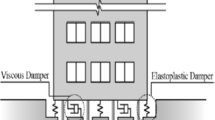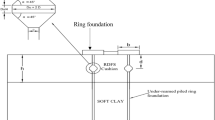Two reinforced soil retaining walls with full-height rigid facing were modeled in a centrifuge. One model wall was constructed on a sand foundation with a relative density of 90%, and the other was constructed on a clay foundation with a smaller compression modulus. The model walls were both constructed in three stages, and the reinforcement strain, vertical earth pressure at the base of the facing and backfill, and wall displacement were measured during the last construction stage. Results showed that the deformable foundation would increase facing displacement and reinforcement strain. Additionally, the vertical earth pressure at the base of the facing for the clay foundation case was smaller compared with that for the wall constructed on the sand foundation.
Similar content being viewed by others
References
T. M. Allen, R. J. Bathurst, R. D. Holtz, D. Walters, and W. F. Lee, “A new working stress method for prediction of reinforcement loads in geosynthetic walls,” Can. Geotech. J., 40, No. 5, 976-994 (2003).
B. Huang, R. J. Bathurst, K Hatami, and T. M. Allen, “ Influence of toe restraint on reinforced soil segmental walls,” Can. Geotech. J., 47, No. 8, 885-904 (2010).
Y. Jiang, J. Han, R. L. Parsons, and J. J. Brennan, “Field instrumentation and evaluation of modularblock MSE walls with secondary geogrid layers,” J. Geotech. Geoenviron. Eng., 1142, No. 12, 05016002 (2016).
H. Ahmadi, and A. Bezuijen, “Full-scale mechanically stabilized earth (MSE) walls under strip footing load,” Geotext. Geomembr., 46, No. 3, 297-311 (2018).
T. Yonezawa, T. Yamazaki, M. Tateyama, and F. Tatsuoka, “Design and construction of geosyntheticreinforced soil structures for Hokkaido high-speed train line,” Transp. Geotech., 1, No. 1, 3-20 (2014).
F. Tatsuoka, M. Tateyama, and J. Koseki, “Performance of soil retaining walls for railway embankments,” Soils Found., 36, Special, 311-324 (1996).
F. Tatsuoka, M. Tateyama, J. Koseki, and T. Yonezawa, “Geosynthetic-reinforced soil structures for railways in Japan,” Transp. Infrastruct. Geotech., 1, No. 1, 3-53 (2014).
P. Xu, G. Jiang, H. Huang, Z. Huang, and Z. Wang “ Study on the influence of facing on reinforced soil retaining walls based on centrifuge model tests,” Rock Soil Mech., 40, No. 4, 1-6 (2019).
G. Jiang, P. Xu, and Z. Wang, “Study on the reinforced soil retaining wall with combined panel base on large-scale model test,” Rail. Eng., 58, No. 1, 118-120 (2018).
G. D. Skinner, and R. K. Rowe, “Design and behaviour of a geosynthetic reinforced retaining wall and bridge abutment on a yielding foundation,” Geotext. Geomembr., 23, No. 3, 234-260 (2005).
H. I. Ling, and D. Leshchinsky, “Finite element parametric study of the behavior of segmental block reinforced-soil retaining walls,” Geosynth. Int., 10, No. 3, 77-94 (2003).
E. C. Santos, E. M. Palmeira, and R. J. Bathurst, “Behaviour of a geogrid reinforced wall built with recycled construction and demolition waste backfill on a collapsible foundation,” Geotext. Geomembr., 39, 9-19 (2013).
C. Yoo, and H. Y. Jung, “Case history of geosynthetic reinforced segmental retaining wall failure,” J. Geotech. Geoenviron. Eng., 132, No. 12, 1538-1548 (2006).
C. Yoo, and A. R. Song, “Effect of foundation yielding on performance of two-tier geosynthetic-rein forced segmental retaining walls: a numerical investigation,” Geosynth. Int., 13, No. 5 181-194 (2006).
F. Tatsuoka, D. Hirakawa, M. Nojiri, H. Aizawa, H. Nishikiori, R. Soma, M. Tateyama, and K. Watanabe, “A new type of integral bridge comprising geosynthetic-reinforced soil walls,” Geosynth. Int., 16, No. 4, 301-326 (2009).
J. Koseki, “Use of geosynthetics to improve seismic performance of earth structures,” Geotext. Geomembr., 34, 51-68 (2012).
M. M. El-Emam, and R. J. Bathurst, “Influence of reinforcement parameters on the seismic response of reduced-scale reinforced soil retaining walls,” Geotext. Geomembr., 25, No. 1, 33-49 (2007).
Author information
Authors and Affiliations
Corresponding author
Additional information
Translated from Osnovaniya, Fundamenty i Mekhanika Gruntov, No. 2, p. 30, March-April, 2020.
Rights and permissions
About this article
Cite this article
Xu, P., Jiang, G. Investigation of the Influence of Foundation Deformability on Reinforced Soil Retaining Walls Using Centrifuge Model Tests. Soil Mech Found Eng 57, 155–161 (2020). https://doi.org/10.1007/s11204-020-09651-6
Published:
Issue Date:
DOI: https://doi.org/10.1007/s11204-020-09651-6




